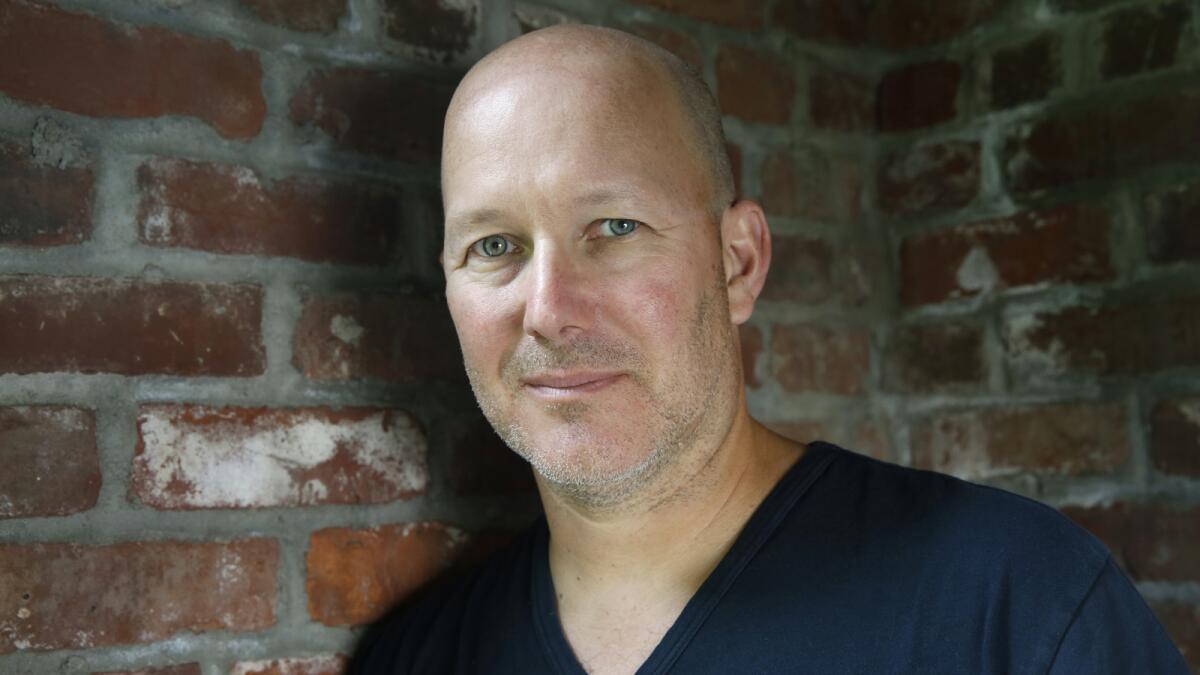Filmmaker Bill Morrison mines cinematic silver and narrative gold in the documentary ‘Dawson City: Frozen Time’
- Share via
Early in his career, filmmaker Bill Morrison would distress film stock with Drano to affect decay. In later films, working largely with archival footage, he meticulously stitched together glorious black-and-white images, allowing the inherent volatility of the medium to create beauty and meaning.
“I became enamored of the way time could ravage film on its own and see what the great ocean of time could affect rather than my own manipulations,” says the filmmaker in a recent phone interview from his home in New York City. His latest nonfiction feature, “Dawson City: Frozen Time,” a unique film borne of Morrison’s distinctive process, opens June 16 at the Nuart.
The film’s inciting incident is the 1978 Dawson City film find, when more than 500 nitrate films from the silent era were discovered in the permafrost-filled swimming pool of an abandoned recreation center in the Yukon. The trove included narrative features, shorts, serials and newsreels, including footage of the 1917 and 1919 World Series. A more conventional filmmaker could have made a fine documentary on the discovery and its aftermath, but Morrison is not your typical documentarian.
The director’s previous work includes “Decasia” (2002), about deteriorated nitrate film; “The Miners’ Hymns” (2010), on the fate of English miners; and “The Great Flood” (2012), which depicts a 1927 Mississippi River disaster. “These films existed somewhere between the experimental, the avant-garde and the documentary form, and all of them show some kind of nitrate decay or damage to the emulsion,” says Morrison. “I was preparing myself for [‘Dawson City’], which really combines all of them in the history and the poetry.”

The film’s foundations go back to a 1997 short, “The Film of Her,” Morrison made about the paper print collection at the Library of Congress. “I told that story,” he says, “essentially, using pieces of that collection and supporting archival material. I thought I could do the same thing with ‘Dawson City’ in the right circumstance.”
The “right circumstance” emerged in 2013 when Morrison was invited to screen some of his films at Ottawa’s ByTowne Cinema. A programmer there, Paul Gordon, mentioned his day job was digital migration at Library and Archives Canada, Morrison inquired about the famous Dawson City footage and was soon looking at 35-millimeter prints on a Steenbeck. He realized that not many people had looked at the films when he returned the following year and discovered reels he’d not rewound were still “tails out.”
Gordon helped Morrison navigate some of the archive’s other holdings, allowing the filmmaker to secure supporting photographs and materials, and eventually became an associate producer on “Dawson City.” Morrison made several trips back and forth to Ottawa before telling them, “You know what? I want it all, basically. I want all the newsreels, and I’ll try to be selective with the narratives.” The digital migration allowed the archive to ship materials to Morrison on drives, and he created his own database of the footage.
It’s nitrate. It’s so gorgeous the way it holds the silver, and the blacks are so rich. There were great artists back then making films.
— “Dawson City: Frozen Time” director Bill Morrison
“I wanted a good portion of the collection to be represented,” says Morrison. “It’s nitrate. It’s so gorgeous the way it holds the silver, and the blacks are so rich. There were great artists back then making films. Sometimes that gets lost in the plots or the acting styles of silent films.” He estimates that 40% of “Dawson City: Frozen Time” is made of footage from the film find, supported by home movies, industrial films and photographs and a small number of interviews.
Morrison does all of his own research and editing. “I think of the two things as inextricably linked,” he explains. “I have to know where everything is, what we have and what we don’t have. It’s really how I write. The writing came as I was doing it.
“I like to start with a discovery and then fill out a back story from there,” Morrison says. “Rather than trying to find a needle in a haystack, I’d rather start with a diamond and find the mines.”
That approach led him to the late 19th century. Before there was a Dawson City, there was a First Nation Hän settlement called Tr’ochëck at a bend in the Yukon River, tucked into Canada’s far northwest. When gold was discovered there in 1896, the Hän were displaced and the town of Dawson City was established. The explosive boom and equally rapid bust form the real start of Morrison’s story.
He realized that the gold rush was concurrent with the birth of cinema, and the history of film in Dawson City was the history of cinema throughout the century. For Morrison, this epic tale represented nothing less than “the story of capitalism as told through cinema and shown through this town.”
The result is an historical epic that spans the better part of the 20th century and includes a cast of thousands, including a string of surprising characters who would later find fame in Hollywood. “I guess you could say the same crazy people who would try to find gold up in the Yukon are the same people who would try to find it in Hollywood,” Morrison says.
Another consistently vibrant component in Morrison’s work is music, having worked with composers and musicians such as Michael Gordon, Bill Frisell, Dave Douglas, Vijay Iyer and others. “[Music] was always something that really inspired me in cinema,” recalls the filmmaker. “Even ‘Rocky,’ not just the theme song but how the strings worked through the fight sequences. I was really intrigued by that. Then when I saw ‘Koyaanisqatsi,’ I was, Oh, music can be your narrator and you don’t even need a plot, per se.”
I guess you could say the same crazy people who would try to find gold up in the Yukon are the same people who would try to find it in Hollywood.
— Bill Morrison
On one of his trips to Ottawa, Morrison met with guitarist-vocalist Jónsi of the Icelandic band Sigur Rós and his frequent collaborator, Alex Somers, backstage at a concert. Later, in New York, after looking at the footage, the duo produced a demo that so impressed the director he used it with the pair’s 2009 album “Riceboy Sleeps” as a temporary “scratch” track for the film. Jónsi went on tour, but Somers eventually composed the eerie, churning score for “Dawson City” and recommended his brother, John Somers, as sound designer.
They created a soundscape that reflects both an accompaniment and a counterpoint to Morrison’s images and themes. John Somers developed a program that monitored the degree of decay in each frame and created a correlative audio component, giving the film an even more haunting quality.
Morrison ultimately sees the story as a grand tragedy, a mystery — how did those films get into the ground? — that reveals both human resilience and hubris. “I liken making the film to working on a huge jigsaw puzzle,” he says. “You know where the edges are but you don’t know how you’re going to fill in the middle. In the end, everything interlocks. There’s a reason the image before it is before it, and the image after it is after it, so it makes sense visually as part of an edit, as well as historically and narratively.”
For audiences, Morrison says, “I want you to have that sensation of having lived through the century, that you went through all the decades, that you worked up to that point. The minutiae is really the point of it. What gets saved, what gets lost, what gets forgotten, what gets remembered.”

See the most-read stories in Entertainment this hour »
Movie Trailers
ALSO
‘Dawson City: Frozen Time’ details the astonishing discovery of a treasure-trove of forgotten film
Ethan Hawke lets us in his editing room and reveals what Philip Seymour Hoffman taught him
Kevin Hart goes dramatic for the Hollywood remake of the French hit ‘Intouchables’
More to Read
Only good movies
Get the Indie Focus newsletter, Mark Olsen's weekly guide to the world of cinema.
You may occasionally receive promotional content from the Los Angeles Times.











